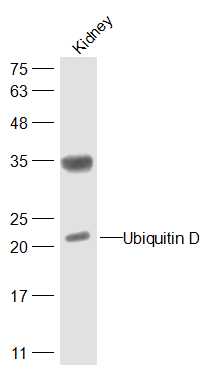
Rabbit Anti-Ubiquitin D antibody
Diubiquitin; FAT10; UBD 3; Ubd; UBD_HUMAN; Ubiquitin D; Ubiquitin like protein FAT10; Ubiquitin-like protein FAT10.
View History [Clear]
Details
Product Name Ubiquitin D Chinese Name UbiquitinD抗体 Alias Diubiquitin; FAT10; UBD 3; Ubd; UBD_HUMAN; Ubiquitin D; Ubiquitin like protein FAT10; Ubiquitin-like protein FAT10. Research Area Tumour Cell biology Neurobiology Apoptosis Cell differentiation lymphocyte b-lymphocyte The new supersedes the old Ubiquitin Immunogen Species Rabbit Clonality Polyclonal React Species Mouse, Rat, (predicted: Human, Dog, Pig, Cow, Horse, Rabbit, Sheep, ) Applications WB=1:500-2000 ELISA=1:5000-10000
not yet tested in other applications.
optimal dilutions/concentrations should be determined by the end user.Theoretical molecular weight 18kDa Cellular localization The nucleus cytoplasmic Form Liquid Concentration 1mg/ml immunogen KLH conjugated synthetic peptide derived from human Ubiquitin D: 55-165/165 Lsotype IgG Purification affinity purified by Protein A Buffer Solution 0.01M TBS(pH7.4) with 1% BSA, 0.03% Proclin300 and 50% Glycerol. Storage Shipped at 4℃. Store at -20 °C for one year. Avoid repeated freeze/thaw cycles. Attention This product as supplied is intended for research use only, not for use in human, therapeutic or diagnostic applications. PubMed PubMed Product Detail FAT10, also designated Ubiquitin D or Diubiquitin, is a 165 amino acid protein encoded in the major histocompatibility complex (MHC) that consists of two domains which share significant homology with ubiquitin. Each domain contains two cysteines, along with a free C-terminal diglycine motif required for FAT10 conjugate formation. FAT10 is inducible by interferon-g and tumor necrosis factor a (TNF?). The FAT10 protein interacts with MAD2, a component of the spindle checkpoint, and plays a role in antigen presentation, cytokine response, apoptosis and mitosis. It may also regulate cell growth during dendritic cell or B cell activation and development. FAT10 mRNA is expressed mainly in some dendritic cells and lymphoblastoid lines and in other specific cells subsequent to interferon-g induction. The human FAT10 gene, designated UBD, maps to chromosome 6p21.3 and is overexpressed in the tumors of various epithelial cancers.
Function:
Ubiquitin-like protein modifier which can be covalently attached to target protein and subsequently leads to their degradation by the 26S proteasome, in a NUB1L-dependent manner. Probably functions as a survival factor. Conjugation ability activated by UBA6. Promotes the expression of the proteasome subunit beta type-9 (PSMB9/LMP2). Regulates TNF-alpha-induced and LPS-mediated activation of the central mediator of innate immunity NF-kappa-B by promoting TNF-alpha-mediated proteasomal degradation of ubiquitinated-I-kappa-B-alpha. Required for TNF-alpha-induced p65 nuclear translocation in renal tubular epithelial cells (RTECs). May be involved in dendritic cell (DC) maturation, the process by which immature dendritic cells differentiate into fully competent antigen-presenting cells that initiate T cell responses. Mediates mitotic non-disjunction and chromosome instability, in long-term in vitro culture and cancers, by abbreviating mitotic phase and impairing the kinetochore localization of MAD2L1 during the prometaphase stage of the cell cycle. May be involved in the formation of aggresomes when proteasome is saturated or impaired. Mediates apoptosis in a caspase-dependent manner, especially in renal epithelium and tubular cells during renal diseases such as polycystic kidney disease and Human immunodeficiency virus (HIV)-associated nephropathy (HIVAN).
Subcellular Location:
Nucleus. Cytoplasm. Accumulates in aggresomes under proteasome inhibition conditions.
Tissue Specificity:
Constitutively expressed in mature dendritic cells and B cells. Mostly expressed in the reticuloendothelial system (e.g. thymus, spleen), the gastrointestinal system, kidney, lung and prostate gland.
Post-translational modifications:
Can be acetylated.
Similarity:
Contains 2 ubiquitin-like domains.
SWISS:
O15205
Gene ID:
10537
Database links:Entrez Gene: 10537 Human
Entrez Gene: 24108 Mouse
Omim: 606050 Human
SwissProt: O15205 Human
SwissProt: P63072 Mouse
Unigene: 44532 Human
Unigene: 140210 Mouse
Product Picture
Bought notes(bought amounts latest0)
No one bought this product
User Comment(Total0User Comment Num)
- No comment



 +86 571 56623320
+86 571 56623320
 +86 18668110335
+86 18668110335

